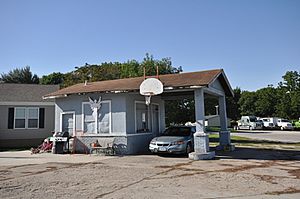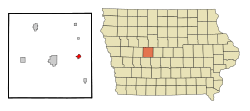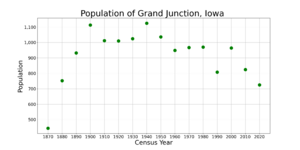Grand Junction, Iowa facts for kids
Quick facts for kids
Grand Junction, Iowa
|
|
|---|---|
 |
|

Location of Grand Junction, Iowa
|
|
| Country | |
| State | |
| County | Greene |
| Area | |
| • Total | 0.97 sq mi (2.51 km2) |
| • Land | 0.97 sq mi (2.51 km2) |
| • Water | 0.00 sq mi (0.00 km2) |
| Elevation | 1,034 ft (315 m) |
| Population
(2020)
|
|
| • Total | 725 |
| • Density | 748.19/sq mi (288.79/km2) |
| Time zone | UTC-6 (Central (CST)) |
| • Summer (DST) | UTC-5 (CDT) |
| ZIP code |
50107
|
| Area code(s) | 515 |
| FIPS code | 19-31980 |
| GNIS feature ID | 2394949 |
Grand Junction is a small city located in Greene County, Iowa, in the United States. In 2020, about 725 people lived there. It's a quiet place with a rich history tied to the railroads.
Contents
History of Grand Junction
Grand Junction got its unique name because it was a very important meeting point for two major railroads. These were the Keokuk and Des Moines railroad and the Chicago and Northwestern railroad. Imagine two main train lines coming together! The city officially became a town in 1873.
Geography of Grand Junction
Grand Junction is a city that covers a total area of about 0.97 square miles (2.51 square kilometers). All of this area is land, meaning there are no large lakes or rivers within the city limits.
Population and People
The number of people living in Grand Junction has changed over the years. You can see how the population has grown and shrunk by looking at the chart below.
| Historical populations | ||
|---|---|---|
| Year | Pop. | ±% |
| 1870 | 444 | — |
| 1880 | 752 | +69.4% |
| 1890 | 932 | +23.9% |
| 1900 | 1,113 | +19.4% |
| 1910 | 1,012 | −9.1% |
| 1920 | 1,010 | −0.2% |
| 1930 | 1,025 | +1.5% |
| 1940 | 1,125 | +9.8% |
| 1950 | 1,036 | −7.9% |
| 1960 | 949 | −8.4% |
| 1970 | 967 | +1.9% |
| 1980 | 970 | +0.3% |
| 1990 | 808 | −16.7% |
| 2000 | 964 | +19.3% |
| 2010 | 824 | −14.5% |
| 2020 | 725 | −12.0% |
| Source: and Iowa Data Center Source: |
||
In 2020, there were 725 people living in Grand Junction. The city had about 308 households. The average age of people in the city was around 44.1 years old. About 24.1% of the people were under 20 years old, and 20.1% were 65 years or older.
Education in Grand Junction
Students living in Grand Junction attend schools that are part of the Greene County Community School District. This school district runs Greene County Elementary, Greene County Middle, and Greene County High schools, all located in Jefferson, Iowa.
For many years, Grand Junction had its own schools. In 1959, the Grand Junction and Dana school districts joined together to create the East Greene Community School District. At first, elementary students went to school in Rippey, Iowa, while older students attended middle and high school in Grand Junction.
Later, in 2012, the elementary students moved to Grand Junction. The older students started attending schools run by the Jefferson–Scranton Community School District. Then, on July 1, 2014, the East Greene and Jefferson–Scranton districts combined to form the current Greene County Community School District.
The Greene County district continued to use the Grand Junction school building until 2017. After that, the city decided to take down the old school building. However, they kept the playground so that kids and families in the area could still use it for fun!
See also
 In Spanish: Grand Junction (Iowa) para niños
In Spanish: Grand Junction (Iowa) para niños


